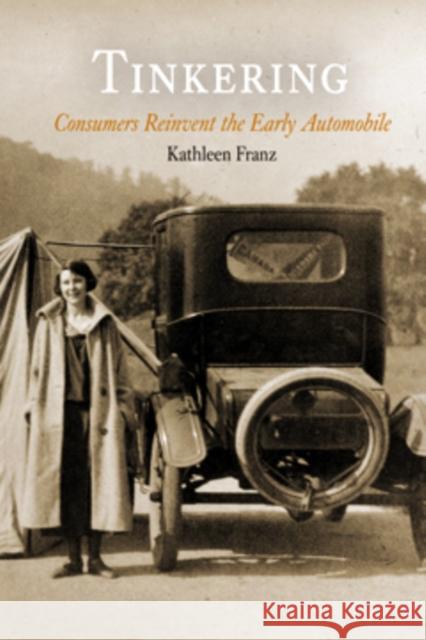Tinkering: Consumers Reinvent the Early Automobile » książka
Tinkering: Consumers Reinvent the Early Automobile
ISBN-13: 9780812221589 / Angielski / Miękka / 2011 / 232 str.
Tinkering Consumers Reinvent the Early Automobile Kathleen Franz "A welcome addition to the growing literature on users of technology and the cultural history of the automobile."--Journal of American History "A well written, valuable contribution to the state of the art of mobility history, even as it opens up a whole new subfield. It is also a valuable addition to consumption studies within and without the history of technology."--American Historical Review In the first decades after mass production, between 1913 and 1939, middle-class Americans not only bought cars but also enthusiastically redesigned them. By examining the ways Americans creatively adapted their automobiles, Tinkering takes a fresh look at automotive design from the bottom up, as a process that included manufacturers, engineers, advice experts, and consumers in various guises. Franz argues that automobile ownership opened new possibilities for ingenuity among consumers even as large corporations came to control innovation. Franz weaves together a variety of sources, from serial fiction to corporate documents, to explore tinkering as a form of authority in a culture that valued ingenuity. Women drivers represented one group of consumers who used tinkering to advance their claim to social autonomy. Some canny drivers moved beyond modifying their individual cars to become independent inventors, patenting and selling automotive accessories for the burgeoning national demand for aftermarket products. Earl S. Tupper was one such tinkerer who went on to invent Tupperware. These savvy tinkerers worked in a changing landscape of invention shaped increasingly by automotive giants. By the 1930s, Ford and General Motors worked to change the popular discourse of ingenuity and used the world's fairs of the Depression as a stage to promote a hierarchy of innovation. Franz not only demonstrates the entrepreneurial spirit of American consumers but she engages larger historical questions about gender, consumption and ingenuity while charting the impact corporate expansion on tinkering during the first half of the twentieth century. Kathleen Franz teaches history and is Director of Public History at American University. 2005 232 pages 6 x 9 22 illus. ISBN 978-0-8122-3881-5 Cloth $45.00s 29.50 ISBN 978-0-8122-2158-9 Paper $24.95s 16.50 World Rights American History Short copy: Tinkering takes a fresh look at early automotive design from the bottom up, as a process that included manufacturers, engineers, designers, advice experts, and consumers, from savvy buyers to grass-roots inventors.
TinkeringConsumers Reinvent the Early AutomobileKathleen Franz"A welcome addition to the growing literature on users of technology and the cultural history of the automobile."--Journal of American History"A well written, valuable contribution to the state of the art of mobility history, even as it opens up a whole new subfield. It is also a valuable addition to consumption studies within and without the history of technology."--American Historical ReviewIn the first decades after mass production, between 1913 and 1939, middle-class Americans not only bought cars but also enthusiastically redesigned them. By examining the ways Americans creatively adapted their automobiles, Tinkering takes a fresh look at automotive design from the bottom up, as a process that included manufacturers, engineers, advice experts, and consumers in various guises.Franz argues that automobile ownership opened new possibilities for ingenuity among consumers even as large corporations came to control innovation. Franz weaves together a variety of sources, from serial fiction to corporate documents, to explore tinkering as a form of authority in a culture that valued ingenuity. Women drivers represented one group of consumers who used tinkering to advance their claim to social autonomy. Some canny drivers moved beyond modifying their individual cars to become independent inventors, patenting and selling automotive accessories for the burgeoning national demand for aftermarket products. Earl S. Tupper was one such tinkerer who went on to invent Tupperware.These savvy tinkerers worked in a changing landscape of invention shaped increasingly by automotive giants. By the 1930s, Ford and General Motors worked to change the popular discourse of ingenuity and used the world's fairs of the Depression as a stage to promote a hierarchy of innovation. Franz not only demonstrates the entrepreneurial spirit of American consumers but she engages larger historical questions about gender, consumption and ingenuity while charting the impact corporate expansion on tinkering during the first half of the twentieth century.Kathleen Franz teaches history and is Director of Public History at American University.2005 | 232 pages | 6 x 9 | 22 illus.ISBN 978-0-8122-3881-5 | Cloth | $45.00s | L29.50 ISBN 978-0-8122-2158-9 | Paper | $24.95s | L16.50 World Rights | American HistoryShort copy:Tinkering takes a fresh look at early automotive design from the bottom up, as a process that included manufacturers, engineers, designers, advice experts, and consumers, from savvy buyers to grass-roots inventors.











